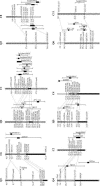Comparison of quantitative trait loci for adaptive traits between oak and chestnut based on an expressed sequence tag consensus map
- PMID: 16204213
- PMCID: PMC1456181
- DOI: 10.1534/genetics.105.048439
Comparison of quantitative trait loci for adaptive traits between oak and chestnut based on an expressed sequence tag consensus map
Abstract
A comparative genetic and QTL mapping was performed between Quercus robur L. and Castanea sativa Mill., two major forest tree species belonging to the Fagaceae family. Oak EST-derived markers (STSs) were used to align the 12 linkage groups of the two species. Fifty-one and 45 STSs were mapped in oak and chestnut, respectively. These STSs, added to SSR markers previously mapped in both species, provided a total number of 55 orthologous molecular markers for comparative mapping within the Fagaceae family. Homeologous genomic regions identified between oak and chestnut allowed us to compare QTL positions for three important adaptive traits. Colocation of the QTL controlling the timing of bud burst was significant between the two species. However, conservation of QTL for height growth was not supported by statistical tests. No QTL for carbon isotope discrimination was conserved between the two species. Putative candidate genes for bud burst can be identified on the basis of colocations between EST-derived markers and QTL.
Figures


References
-
- Ahmadian, A., 2001. Approaches for Analysis of Mutations and Genetic Variations. Department of Biotechnology, Royal Institute of Technology, KTH, Stockholm.
-
- Alba, R., Z. Fei, P. Payton, Y. Liu, S. L. Moore et al., 2004. ESTs, cDNA microarrays, and gene expression profiling: tools for dissecting plant physiology and development. Plant J. 39: 697–714. - PubMed
-
- Altschul, S. F., W. Gish, W. Miller, E. W. Myers and D. J. Lipman, 1990. Basic local alignment search tool. J. Mol. Biol. 215: 403–410. - PubMed
-
- Arcade, A., A. Labourdette, M. Falque, B. Mangin, F. Chardon et al., 2004. BioMercator: integrating genetic maps and QTL towards discovery of candidate genes. Bioinformatics 20: 2324–2326. - PubMed
Publication types
MeSH terms
Substances
LinkOut - more resources
Full Text Sources
Research Materials

